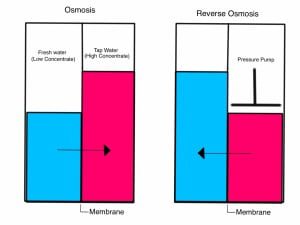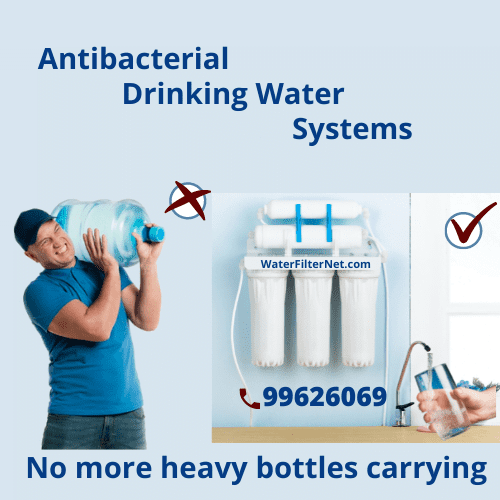Multi-Stage Reverse Osmosis Smart Water Filter
- Removes common chemical contaminants (such as metal ions, aqueous salts), including sodium, chloride, copper, chromium, and lead;
- High efficacy in removing bacteria (such as, Campylobacter, Salmonella, Shigella, E. coli);
- High efficacy in removing viruses (such as, Enteric, Hepatitis A, Norovirus, Rotavirus)
Need Some Help?
Contact us
Product Delivery
3-5 business days
Multi-Stage Reverse Osmosis Smart Water Filter is an Innovative R/O unit with a low pressure membrane. Can be easily installed below the kitchen counter, while a small faucet is mounted on the sink. Small size, input pressure gauge.
Suggested Filter Series:
- Granular activated carbon, G.A.C.
- Polypropylene, 1 micron
- Desalination Membrane 50G.P.D. 0,0001m
- Powdered Granular activated carbon, PAC
SPECIFICATIONS
| Pump | 24V |
| Transformer | 1.2A |
| Tank | 8lt |
| Thermo-electric valve | 24 V-DC |
| pressure switch, low-high pressure | |
| Conductance regulator | |
DIMENSIONS
| Width | 32cm |
| Depth | 12cm |
| Height | 40cm |
Table of contents:
What is Reverse Osmosis or RO system?
Reverse osmosis or RO for short, is a filtration process for water purification. In order to fully understand what reverse osmosis is, you first must understand what osmosis is.
Osmosis is the movement of water from a low concentration solution to a higher solute concentration. This is also known as diffusion. The water passes through the semipermeable membrane in an attempt to equalize the concentrations of both sides of the membrane.
The semipermeable membrane is a type of membrane that allows only certain molecules or ions to pass through. It is usually made up of many layers of either cellulose acetate or polyamide resins material. The membrane blocks all of the contaminants from coming through when pressure is applied to the water.
Reverse osmosis filtration systems contains many different type of membranes and each membrane?s pore size determines the amount of contaminants it is able to remove.
So what is considered a high concentration solution? It is basically any type of liquid solution (such as water) that has a large amount of molecules (such as salt, sugar, fluorides, nitrates, ect.)
A low concentration solution is the just the exact opposite. It is a liquid solution that has a small amount of molecules.
Example: Fresh water is considered a low concentrate compared to tap water.
Reverse osmosis or RO is basically the process of reversing the osmosis method. Same procedure, just the opposite. It does this by using a pump to build pressure and as the pressure rises, the tap water moves through the membrane to the other side. Thus leaving behind all the toxic chemicals and resulting in a clean, purified water.

Reverse osmosis water (RO water)
Why should you drink reverse osmosis water?
Water is essential to your body?s health. It is the main nutrient to all living cells in your body. If you don?t have good drinking water, your cells aren?t likely to absorb the water to its full potential.
Here are some great benefits for why anyone should drink clean purified water:
- Helps better maintain body temperature. (sweating)
- Helps better remove toxin waste from internal organ
- Aids in digestion and prevents constipation
- Moisturize the skin fully
- Helps the body better absorb nutrients and energy efficiently
- Drinking purified water helps blood flow and cellular reproduction
Reverse Osmosis or RO water is pure due to the fact that almost all impurities in the feed water has been removed. Some of the main toxic contaminants that the RO system removes are:
Ions and Metals:
- Arsenic ? Magnesium
- Antimony ? Mercury
- Aluminum ? Nitrate
- Beryllium ? Potassium
- Cadmium ? Radium
- Calcium ? Radon
- Chloride ? Selenium
- Chlorine ? Silver
- Chromium ? Sodium
- Copper ? Sulfate
- Fluoride ? Thallium
- Iron ? Zinc
- Lead
Particles:
- Asbestos
- Protozoan cysts
- Cryptosporidium
Pesticides:
- Endrin
- Heptachlor
- Lindane
- Pentachlorophenol
Four Main Toxic Chemicals in Water:
Fluoride: Fluoride is a compound consisting of fluorine which is usually used in toothpaste because it reduces the ability of bacteria to stick onto the teeth. So why is it so dangerous? Well, it has been known that fluoride is very toxic at certain levels of concentrations and when it is put in tap water, the amount of fluoride can?t be controlled. This is especially dangerous for people who have weak kidneys and needs to intake lots of water throughout the day. When ingesting large amounts of fluoride, it can cause damage to soft tissues such as kidneys, the brain, and even bones.
Chlorine: Chlorine in drinking water is often used to reduce the risks of pathogens and diseases. Although chlorine is used as a chemical agent to prevent diseases, the chlorine itself has been known to cause cancer and diminished health. A study in the medical college of Wisconsin found that people who regularly drink water with chlorine had a higher chance of getting bladder and rectal cancer as much as 80% versus people who drink clean purified water.
Arsenic: Arsenic is an element naturally found in air, soil and earth. It can be found in tap water through natural means or agricultural practices. People who drink water with arsenic may experience skin damage and even cancer. Studies of people in southeast asian with large amounts of arsenic in their water has been shown to have higher rates of lung cancer, leukemia, and stomach cancer.
Radium: Naturally found in rocks, soil, and ground water. Radium is considered a hazard when ingested because when it enters the body only a small amount of it is digested into the intestines. The rest of the chemical is distributed throughout the body. Some places that the radium can enter is the bone tissue. When this happens it can caused serious damaged over time, including bone cancer and bone fractures.
Reverse Osmosis has been known to be one of the best methods in purifying unclean water which can then be used for drinking, cooking and even for aquariums.
Other best selling RO water purifier.
Read More About the RO water treatment filtration system by clicking here.
100% privacy guarantee
Your privacy is our priority: We guarantee 100% data protection, never sell your information, and only send you relevant updates—no spam, no nonsense.
Pay upon delivery
Enjoy the convenience of Pay Upon Delivery – shop online now and pay only when your order arrives at your doorstep!



Reviews
There are no reviews yet.